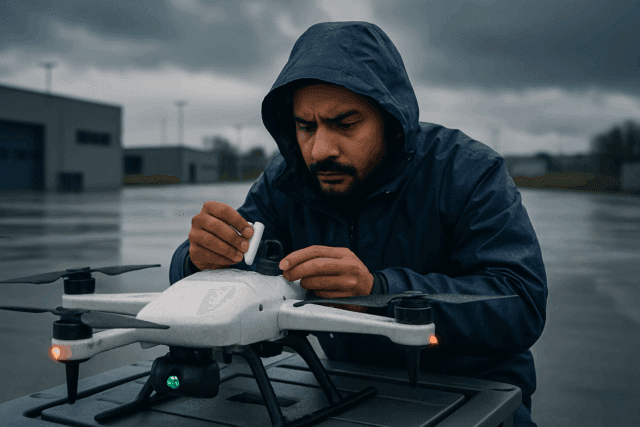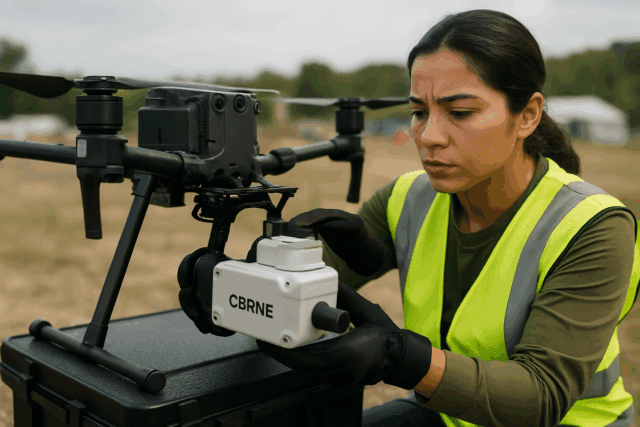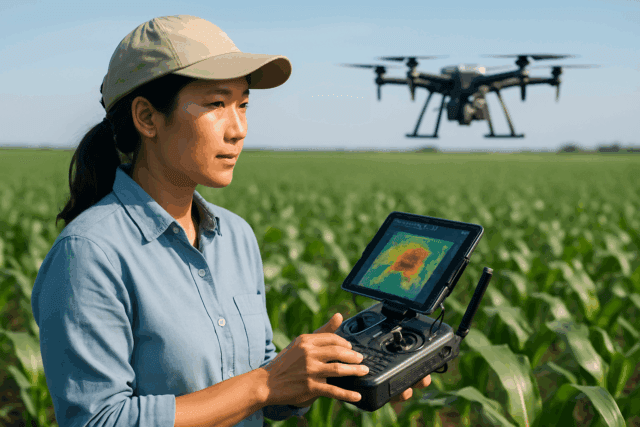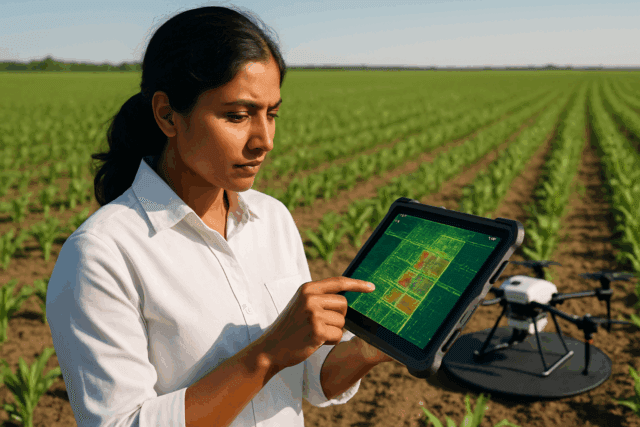The commercial drone industry is undergoing a profound transformation, driven by innovations in unmanned aerial vehicle (UAV) technologies, regulatory frameworks, and advanced power systems. Key areas shaping this evolution include the development of Unmanned Aerial System Traffic Management (UTM), the emergence of synergistic drone-helicopter partnerships, and the groundbreaking potential of solid-state batteries. These interconnected advancements are collectively enhancing the safety, efficiency, and operational capabilities of commercial drones, unlocking new applications across diverse sectors.
Unmanned Aerial System Traffic Management (UTM)
Unmanned Aerial System Traffic Management (UTM) refers to a collaborative ecosystem designed to safely and efficiently manage unmanned aircraft operations, particularly at low altitudes. It functions separately from, yet complements, traditional Air Traffic Management (ATM) systems for manned aircraft. The primary objective of UTM is to enable the safe, efficient, and scalable integration of a growing number of drones into national airspaces, especially for operations beyond visual line of sight (BVLOS).
Core Components and Functions of UTM
UTM systems are built on a framework of regulatory requirements, technical capabilities, and interoperable services. Key functions include:
- Flight Planning and Authorization: Allowing drone operators to submit flight plans and receive dynamic authorizations based on real-time airspace conditions and constraints.
- Surveillance and Tracking: Monitoring the positions of drones and other airspace users to maintain situational awareness.
- Conflict Management and De-confliction: Identifying and resolving potential conflicts between multiple drones and between drones and manned aircraft to prevent collisions.
- Information Exchange: Facilitating the seamless sharing of critical data, such as weather conditions, airspace restrictions, and real-time traffic information, among drone operators, service providers, and aviation authorities like the FAA.
- Automation and Advanced Decision-Making: Employing high levels of automation and advanced algorithms to manage complex drone operations efficiently.
Key Initiatives and Development
Global efforts are underway to develop and implement robust UTM systems. In the United States, the Federal Aviation Administration (FAA) and NASA have been leading the charge. NASA’s UAS Traffic Management project has conducted extensive research and field demonstrations, collaborating with industry and academia to develop the foundational technologies for low-altitude airspace access. This research aims to create a cloud-based software architecture that facilitates organized drone flight.
In Europe, the counterpart to UTM is known as U-space. This initiative, supported by the SESAR Joint Undertaking, Eurocontrol, and industry partners, defines a set of new services relying on high levels of digitalization and automation to support safe and secure drone access to airspace. European regulations have required the implementation of U-space systems since January 26, 2023. The International Civil Aviation Organization (ICAO) has also adopted the UTM concept, recognizing its importance for integrating unmanned aircraft into very low-level airspace.
Challenges and Future Outlook for UTM
Despite significant progress, challenges remain in the widespread adoption and scalability of UTM. These include the need for global standardization to harmonize regulations across different regions, the continuous development and integration of advanced technologies like AI and machine learning, and addressing market uncertainty to guide investment decisions. Interoperability between different systems is also crucial for global scalability.
The future of UTM is intertwined with the expansion of high-volume drone services such as package delivery and urban air mobility (UAM), including air taxis and electric vertical takeoff and landing (eVTOL) vehicles. UTM is essential for enabling routine, safe, and efficient BVLOS drone operations. As the drone industry matures, UTM systems will become more flexible, scalable, and adaptable, managing a diverse range of aerial activities while maintaining the highest safety standards. Proven UTM technologies are also likely to be adapted and merged with current ATM systems and procedures.
Drone-Helicopter Partnership
While drones are rapidly expanding their operational scope, manned helicopters continue to play a crucial role in various aerial missions. Increasingly, the aviation industry is recognizing the significant advantages of fostering partnerships between drones and helicopters, leading to a “man-unmanned hybrid mode” that leverages the unique strengths of each platform.
Synergistic Benefits and Applications
The collaboration between drones and helicopters offers numerous benefits, enhancing operational efficiency, safety, and cost-effectiveness.
- Complementary Capabilities: Helicopters excel in heavy-lift operations, long-range missions, and high-speed response, while drones offer versatility, the ability to access confined or hazardous spaces, prolonged overwatch, and discreteness.
- Enhanced Situational Awareness: In law enforcement, for example, helicopters can provide initial rapid response and wide-area coverage, while drones can then take over for prolonged incident overwatch, detailed inspections of specific areas, or maintaining aerial coverage during helicopter refueling periods. The Fairfax County Police Department and Alachua County Sheriff’s Office have successfully demonstrated this synergy in public safety operations.
- Cost-Effectiveness: Drones can often perform tasks at a lower operational cost than helicopters, especially for missions requiring prolonged presence or access to difficult terrains.
- Improved Safety: Drones can undertake dangerous tasks that would otherwise expose human pilots to risk, such as inspecting damaged infrastructure or entering hazardous environments.
These partnerships are manifesting in various applications:
- Law Enforcement and Public Safety: Providing continuous surveillance, search and rescue, and supporting ground operations.
- Logistics and Transportation: Transporting supplies to remote or inaccessible areas, and even exploring the delivery of critical items like human organs. PHI Helicopters, for instance, has partnered with Kaman Aerospace for Kaman Kargo drones for logistics missions.
- Infrastructure Inspection: Utilizing drones for detailed inspection of pipelines, power lines, and other critical infrastructure, with helicopters providing broader oversight or rapid deployment.
- Agriculture: Unmanned helicopters and drones are revolutionizing crop spraying and monitoring, offering precise application and increased coverage while reducing human exposure to chemicals.
- Emergency Response: Rapid deployment for reconnaissance, carrying supplies, and even evacuating wounded individuals. ADAC Luftrettung and Volocopter are exploring the use of eVTOLs (a type of drone-like aircraft) in Helicopter Emergency Medical Services (HEMS) operations.
Challenges and Future Directions
While the synergy is clear, integrating drone and helicopter operations requires effective communication and coordination to ensure a unified approach to airspace management. The future will likely see further evolution towards “man-unmanned hybrid modes,” with helicopters carrying and deploying drones, and increased integration of AI and electrification across both platforms. This collaborative approach aims to redefine the aerial mobility landscape, expanding operational capabilities and fostering a more sustainable approach to aviation.
Solid-State Batteries for Drones
Battery technology is a fundamental determinant of a drone’s flight time, payload capacity, and overall performance. While traditional lithium-ion (Li-ion) batteries have been the industry standard, solid-state batteries are emerging as a revolutionary advancement, promising to significantly enhance drone capabilities.
Advantages Over Traditional Lithium-Ion Batteries
Solid-state batteries replace the flammable liquid electrolytes found in traditional Li-ion batteries with a solid electrolyte, leading to several critical advantages:
- Higher Energy Density: Solid-state batteries can store more energy in a given volume or weight, directly translating to significantly longer flight times and increased operational range for drones. For instance, Factorial’s FEST platform offers up to 50% more energy density. Initial modeling suggests this could double an aircraft’s range for a given payload.
- Enhanced Safety: The non-flammable and non-volatile nature of solid electrolytes fundamentally addresses safety risks associated with liquid electrolyte leakage or thermal runaway in Li-ion batteries, making them crucial for operations in sensitive environments or when carrying hazardous materials.
- Improved Performance in Extreme Temperatures: Solid-state batteries can operate effectively across a wider range of temperatures, including extremely low (-40°C) and high (up to 100°C) temperatures, expanding drone applications in harsh environments like arctic reconnaissance or disaster monitoring.
- Faster Charging: Enhanced conductivity can enable faster charging times, reducing downtime and increasing operational efficiency, which is vital for time-sensitive missions. Panasonic, for example, announced a prototype capable of charging from 10% to 80% in 3 minutes.
- Longer Lifespan: Solid-state batteries can endure significantly more charge-discharge cycles, extending their lifespan and reducing replacement costs for commercial drone operators.
- Potential for Weight Reduction: The inherent safety of solid electrolytes may reduce the need for bulky thermal management systems, potentially leading to lighter battery packs and increased drone efficiency.
Current State and Industry Players
The development and commercialization of solid-state batteries for drones are advancing rapidly. Several companies are at the forefront of this innovation:
- Factorial Energy (U.S.): A key player developing solid-state battery technology, including their FEST® (Factorial Electrolyte System Technology) platform. They have shipped their first solid-state lithium-metal battery cells for drone use to Avidrone Aerospace Inc., a Canadian developer of high-endurance unmanned aerial systems. This collaboration aims to enhance drone endurance and payload capacity significantly.
- Avidrone Aerospace (Canada): Integrating Factorial’s solid-state cells into their high-endurance cargo drone platforms for demonstration flights.
- Panasonic Holdings Corporation (Japan): Actively investing in solid-state battery research, with a goal to begin mass production by 2027, potentially starting with drones and industrial robots.
- Samsung SDI: A global leader focusing on fully solid-state batteries for high-performance consumer electronics and EVs, with relevance for drones.
- Hitachi Zosen Corporation (Japan): Announced a high-capacity solid-state battery suitable for harsh environments, tested in space by JAXA.
- Vayu Aerospace: A drone manufacturer that reported increased flight time after incorporating solid-state batteries into their G1 long-flight drone.
Challenges to Commercialization
Despite their immense potential, several challenges impede the widespread adoption of solid-state batteries in the drone industry:
- High Production Costs: The materials and complex manufacturing processes, especially for solid electrolytes and thin-film solid-state batteries, are currently more expensive than traditional Li-ion batteries, making them prohibitive for some consumer applications.
- Manufacturing Complexity and Scalability: Scaling up production to meet the demands of the drone industry presents significant hurdles.
- Interface Stability and Cell Resistance: Maintaining stable interfaces between the solid electrolyte and electrodes is crucial for efficient ion transport and performance. Solid-to-solid interfaces can create high resistance, potentially limiting power output and leading to faster degradation.
- Thermal Management: While generally safer, solid-state batteries may not dissipate heat as effectively as liquid electrolytes in high-power applications, requiring new thermal management system designs.
Ongoing research and development efforts are focused on overcoming these challenges, including optimizing lithium-based chemistries and developing new electrolyte materials. The strategic implications for the drone sector are profound, as advanced battery technology is crucial for national defense, critical logistics, and infrastructure resilience. While mass-market solid-state drone batteries may still be a few years away, the progress is rapid, promising to revolutionize drone capabilities in the near future.





